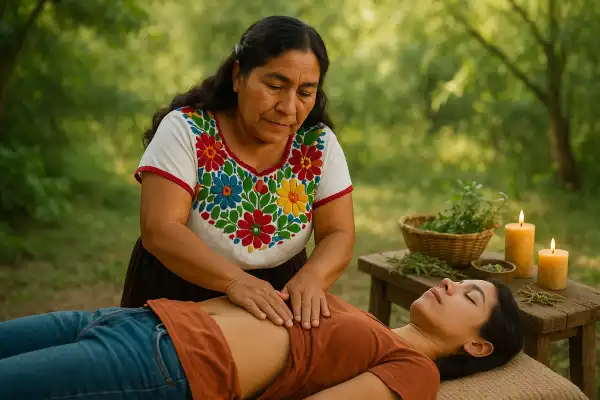Examples of curanderismo reflect a vast tapestry of healing practices that span thousands of years, embodying the wisdom of indigenous Mexican traditions. Many people seek these examples because they recognize something profound is missing from conventional approaches to wellness—a connection to the sacred rhythms of Earth and the understanding that healing encompasses body, mind, and spirit as one unified whole.
María del Pilar Fernández believes deeply in the power of curanderismo to restore balance in our modern lives. Through her years of study and practice within her family’s lineage of curanderas, she has witnessed how these ancestral remedies offer pathways to healing that honor both scientific understanding and sacred knowledge passed down through generations.
Examples of curanderismo
Curanderismo encompasses a rich variety of traditional healing practices that have been used by Mexican and Mexican American communities for over 5,000 years, with practitioners employing various methodologies including herbalism, bodywork, rituals, and spiritual healing. These practices work holistically to address physical, emotional, mental, and spiritual imbalances within individuals and communities.

Limpias (spiritual cleansings)
Limpias are spiritual cleansing rituals that cleanse body, emotions, mind and soul from negative energies or thoughts, traditionally used to get rid of blockages and help people feel light, peaceful and happy. These powerful ceremonies can be performed using various tools and methods.
Egg cleansings represent one of the most recognized forms of limpia. The practitioner rolls an intact egg over the person’s body from head to feet, then cracks it into a glass of water to reveal spiritual blockages through the patterns formed by the egg white and yolk. The unusual formations that appear often provide insight into the nature of energetic disturbances affecting the person.
Herbal limpias utilize the cleansing properties of sacred plants. These can include herbs like rue, rosemary, mugwort, white sage, and basil, prepared as spiritual baths or used in sweeping motions over the body. Each plant carries specific healing energies—rue for protection, rosemary for purification, mugwort for spiritual insight.
Fire limpias work with transformational energy. These ceremonies use candles, copal incense, or tobacco to facilitate renewal and activate sacred essence energy within people and spaces. The practitioner may light candles in specific patterns or use burning tobacco (puros) to cleanse a person’s energy field.
Sobada (traditional massage)
Sobada is a traditional therapeutic massage modality developed in the Mesoamerican region, where practitioners heal individuals through specialized knowledge of massage, bone setting, and spirituality. This practice extends far beyond physical manipulation to address emotional, spiritual, and energetic imbalances.
Abdominal sobada focuses on repositioning internal organs. This treatment helps with digestive problems, fertility issues, and emotional blockages by stimulating blood and lymph circulation and realigning organs to their proper positions. Practitioners often use herbal oils and may apply a faja (wrap) afterward to maintain the organs’ alignment.
Prenatal sobada supports expectant mothers throughout pregnancy. Traditional midwives perform massages on the abdomen, back, and legs to alleviate discomfort, position the uterus optimally, and help turn babies into correct birthing positions.
Temazcal (sweat lodge ceremonies)
The temazcal is an ancient steam bath ritual whose name derives from the Nahuatl word “temazcalli” meaning “house of vapor,” representing the womb of Mother Earth and symbolizing death and rebirth. These ceremonies have been practiced by Mexican indigenous cultures for over 1,000 years.
Participants enter a circular, dome-shaped structure made of stone or mud, where hot volcanic rocks are placed in the center and water with herbs is poured over them to create therapeutic steam. Ceremonies typically last two or more hours and are led by a curandero or temazcalero, involving prayers, chanting, and contemplation for physical, emotional, and spiritual healing.
The heat opens capillaries, improving circulation and lowering blood pressure. The practice also serves as psychological therapy, promoting mental balance and emotional release.
Herbal remedies (yerbería)
Yerberos are primarily herbalists within curanderismo, specialists who work with the healing properties of plants. Traditional plant medicines address everything from digestive issues to spiritual protection.
Aloe vera serves multiple purposes in curanderismo. It’s used topically for skin burns and cuts, and as a digestive aid when consumed, with modern research confirming its anti-inflammatory and antibiotic properties. Traditionally, aloe plants were placed at home entrances to ward off negative spiritual influences.
Medicinal teas and tinctures utilize plants like papaya for digestion and various herbs for specific ailments. These remedies often incorporate plants like mejorana (marjoram), menta (mint), and specialized blends for protection, love, abundance, and healing.
Specialized healing practices
Treatment for empacho addresses a cultural syndrome involving intestinal blockage. This condition is treated through specific abdominal massage techniques that release physical, emotional, and spiritual blockages.
Healing for susto treats a form of spiritual shock or soul loss. This condition, similar to PTSD, requires ceremonies to call back the person’s wandering spirit and restore their vital essence.
Platicas (healing conversations) involve heart-straightening talks. These counseling sessions help people vocalize their needs while ejecting traumas and unwanted energies, setting the stage for self-awareness and healing.
Prayer and spiritual work form the foundation of many practices. Curanderos work through the power of prayer, believing that God or a higher power grants them the gift (el don) to heal and guides their work.
These examples represent just a portion of curanderismo’s vast healing tradition. Each practice connects us to the profound wisdom of our ancestors while addressing the complex needs of modern life. Through respectful engagement with these sacred arts, we can rediscover pathways to wholeness that honor both ancient knowledge and contemporary understanding.
Disclaimer
Please note that Maria is not a physician, psychologist, or nurse. These culture-specific spiritual healing services are not meant to replace medical or psychological diagnosis and treatment. It is recommended that you see a licensed physician or licensed health care professional for any physical or psychological ailment you may have.
Recently, María worked with a young woman named Esperanza who came to her suffering from persistent anxiety and digestive issues that conventional medicine had not been able to resolve. Esperanza, a teacher in her late twenties, described feeling constantly unsettled, as if something was “sitting heavy” in her stomach, accompanied by racing thoughts that kept her awake at night.
After listening carefully to Esperanza’s story, María recognized signs of both empacho (spiritual and physical blockage) and possible susto from a traumatic event in her childhood. She began with a gentle egg limpia, rolling the egg slowly over Esperanza’s body while offering prayers for clarity and healing. When cracked into clear water, the egg revealed cloudy formations with strange tendrils—confirmation of energetic disturbances.
Over the course of three sessions, María performed sobada abdominal massage using warm oil infused with manzanilla and hierbabuena, working to release the physical tension while simultaneously addressing the emotional holding patterns. She taught Esperanza to prepare herbal teas with papaya leaf and aloe vera for digestive healing, and guided her through práticas where she could voice her fears and grief from the childhood trauma.
By the final session, Esperanza reported that the heavy feeling in her stomach had lifted, her sleep had improved dramatically, and she felt reconnected to a sense of inner peace she hadn’t experienced in years. “I felt like I could breathe fully for the first time,” she told María with tears of gratitude in her eyes.
